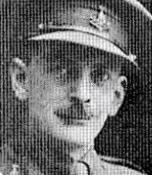
War Memorial
| Lieutenant Colonel Charles Ramsay WHITE DSO, Belgian Order of the Crown, Croix de Guerre | |
|
2nd Battalion Yorkshire Regiment attached to the 6th (Service) Battalion Date of birth: 11th May 1881 Date of death: 31st March 1921 Died aged 39 Buried at St Mary's Church, Tickhill |

|
| Charles Ramsay White was born at "Leahurst", Tickhill in Yorkshire on the 11th of May 1881 the third son of Sir William Knight Hamilton Ramsay White and Lady Edith Laura (nee Paris) White of “Leahurst”, Tickhill near Rotherham. He was educated at Oatlands School, Harrowgate in Yorkshire until 1892 and at Hazelwood School until July 1895. He went on to Wellington College where he was in Hill House from September 1895 to 1898. He was commissioned as a 2nd Lieutenant in the 3rd Battalion Yorkshire Regiment on the 18th of February 1900. He served with them in the South African War from 1900 to 1902, latterly as Regimental Transport Officer. He took part in operations at Cape Colony south of the Orange River from January to August 1900, Orange River Colony from September to the 29th of November 1900 and was there once more from January to April 1902. He was awarded the King’s Medal with two clasps and the Queen’s Medal with two clasps and was promoted to Captain on the 22nd of October 1904 while serving as Battalion Instructor of Musketry. He left the army in 1907 and went into business in Burma. He rejoined the army on the outbreak of war and went out to France as a Captain and as a replacement on the 22nd of November 1914 where he joined the 2nd Battalion of his regiment. At 2.30am on the 10th of March 1915 the 2nd Battalion Yorkshire Regiment marched billets at Laventie and marched to reserve trenches for the attack on Neuve Chappelle. They were to be in support of 23rd Brigade on the Rue Tilleloy and began their advance towards the support trenches at 9am , suffering a few casualties from enemy machine gun fire as they crossed the open ground. They were shelled while they waited in the support line but with no casualties and they advanced again at 2pm when the occupied the old German front line trenches. After a long delay they moved forward once again towards Min du Pietre and a few more men were wounded during this advance. Before long they were forced to dig in as their way was barred by two strongly held enemy redoubts. The following day the battalion bombers, under Corporal 8191 J. Anderson attacked the enemy trench opposite and captured sixty two enemy prisoners. Charles White was wounded in the head during the attack, one of six officer casualties during the day. He was evacuated to England from Boulogne on a Hospital Ship on the 14th of March 1915 and landed at Dover later the same day. A Medical Board sat at Caxton Hall, London on the 22nd of March 1915 to consider his case: - "At the place on the date noted Capt. White was struck in the left upper temporal region by a rifle bullet which inflicted a gutter wound of the scalp two inches in length. Patient was unconscious for a few minutes and suffered from continuous headache for two days afterwards. Now doing very well." He was pronounced as being fit for general service at a Medical Board held at the 3rd Northern General Hospital, Sheffield on the 25th of May 1915. He reported to the 3rd Battalion of his regiment at Hartlepool on the same day. He went to Egypt as a Major later in 1915 and returned to France in 1916. On the 29th of December 1916 he slipped and fell into a shell hole and sprained his left knee. He was evacuated back to England from Le Havre on board the Hospital Ship "Glenart Castle" on the 20th on January 1917 and landed at Southampton the following day. A Medical Board sat at Caxton Hall, London on the 24th of January 1917 to report on his case: - "He fell into a shell hole and twisted left knee. He is now improving. Movements good. Some pain." He was granted leave until the 23rd of February 1917. He took command of the 6th Battalion of his regiment in September 1917 but was sent home sick in May 1918 when the regimental history records: - “For long he had struggled against illness, in fact it may be doubted whether he had ever really been fit enough to be passed for field service.” He was mentioned in despatches on three occasions, was awarded the Belgian Order of the Crown, the Croix de Guerre (Belgium) on the 15th of April 1918 and later became Commanding Officer of the 3rd Battalion. He was awarded the Distinguished Service Order in the King's Birthday Honours List of June 1918. He was demobilised at No. 1 Dispersal Unit, Ripon on the 15th of October 1919. He died suddenly at home. He is not currently commemorated on the Hazelwood School war memorial. |
|
| Went on to Wellington College |
Back